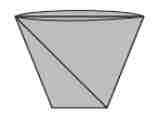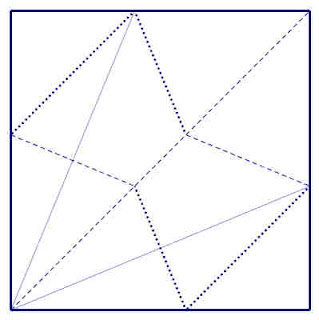The traditional paper cup origami model (diagram available from Origami USA) has some nice properties that, like the hopping frog, make it a nice model for simple mathematical exploration.
As you would expect, when folded flat the top of the cup is parallel to the bottom of the cup. To achieve this there is an interesting fold that is used only to find a point - the crease that this fold creates is not a part of the final model, but only used to help you along the way.
The intermediary fold that marks the point where the corner B is folded over to the side AC (point D) is one that constructs the angle bisector of ABC (see figures below) by folding the side AB onto the side BC.
How does an angle-bisector help us make the top of the cup parallel to the bottom? You can see this pretty clearly if you keep in mind the properties of transversals of parallel lines.
Depending on how you learned about the properties of transversals, you might recognize the "Z-law" that states that alternate interior angles of a transversal of parallel lines are equal.
The angle bisector that results from this gives a set of equal angles that become the alternate interior angles of the fold that transverses the top and bottom of the cup (you can also see this in the finished crease pattern below).
In Ontario, there is a grade nine mathematics curriculum expectation that states that students will "determine, through investigation using a variety of tools (e.g., dynamic geometry software, concrete materials), and describe the properties and relationships of the angles formed by parallel lines cut by a transversal, and apply the results to problems involving parallel lines." I think that investigating the origami paper cup can help here.
Although the origami cup is pretty easy to fold, and as I hope you can see, the "angle bisector" fold is pretty important in getting it right, some versions of the instructions get this wrong. For example, check out the city of Ottawa's compost bin origami instructions. If you watch closely, they get things wrong by using the right-bisectors of the sides of the folded triangle to find their reference points, instead of the angle-bisector. Luckily, newspaper and compost are pretty forgiving.
Monday, January 31, 2011
Thursday, January 13, 2011
simple origami and math - jumping frog
There are a lot of great books and and other resources that demonstrate how origami can be used in mathematics education. One book that comes to mind right away is Tom Hull's Project Origami, another is Jun Maekawa's Genuine Origami - two excellent books that show how origami relates to both simple and complex mathematics concepts.
If you are looking for something for younger folders - something less complicated than the models found in the books mentioned above, there are many simple origami models that can be used to help spark mathematical thinking and exploration with elementary school students. One example is the jumping frog (instructions available on Origami USA's diagram page).
Unlike most traditional origami, the frog is made from a rectangular sheet of card (3x5 works well) - the frog is best made from card stock to give it a stiffness that helps it hop. The frog can be colored after it is completed to make it look more frog-like (younger kids particularly like this - and the jumping).
"Dissecting" the frog by opening it up after it is folded reveals a crease pattern that can spark many mathematical conversations.
If you are looking for something for younger folders - something less complicated than the models found in the books mentioned above, there are many simple origami models that can be used to help spark mathematical thinking and exploration with elementary school students. One example is the jumping frog (instructions available on Origami USA's diagram page).
Unlike most traditional origami, the frog is made from a rectangular sheet of card (3x5 works well) - the frog is best made from card stock to give it a stiffness that helps it hop. The frog can be colored after it is completed to make it look more frog-like (younger kids particularly like this - and the jumping).
"Dissecting" the frog by opening it up after it is folded reveals a crease pattern that can spark many mathematical conversations.
What I like about this model is that every fold involves the constuction of an angle bisector - every crease cuts an angle in half (OK, some of the bisectors are cutting a 180 degree angle in half, but I'm counting those too). This makes it easy to talk about the resulting angles and shapes. Can you identify all the angles? Can you name all the shapes? Can you think of other mathematical conversations you could have with young students about the model and its crease pattern?
Labels:
math,
origami,
school math
Subscribe to:
Posts (Atom)




